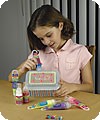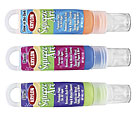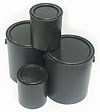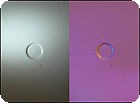Snapshots of Success


Krylon Squeeze Art Paint is Fun for All
Recently Krylon introduced a brand-new way to encourage creativity with Squeeze Art™ squeezable paint. Kids and adults can use any of the 16 fun finishes to create one-of-a-kind T-shirts and backpacks, embellish plastic storage containers, create cards and invitations, and add decorative touches to wood, glass, paper and metal. The paint can be squeezed directly from the easy-to-hold tube or applied with brushes, sponges and rollers.Squeeze Art is washable and will remain soft and flexible through numerous washings. Project ideas include glow-in-the-dark party invitations, embellishing jeans or T-shirts, painting models and action figures, creating handprints as special mementos, or colorful window clings. Kids of all ages benefit from creative expression; art helps them discover their own limitless imaginations. Parents will benefit from Squeeze Art’s “no more waste” flexibility. Forget buying specialty paint for every surface; Squeeze Art is the economical choice for crafting with kids.
Non-toxic, soap-and-water washable Squeeze Art is available in three mix-and-match finishes: glossy, glitter and glow-in-the-dark, and is available in leading craft chains and mass retail outlets nationwide.
For more information, visit www.krylon.com.

Protective Coating Enhances Pump Efficiency
Belzona Inc., a leader in erosion-corrosion technology for over 50 years, announces a major advancement in fluid flow efficiency, combined with outstanding erosion-corrosion protection.
Energy losses due to the effects of viscous drag and surface roughness
accentuated by erosion-corrosion effects are drastically reduced with the
application of Belzona® 1341 (Supermetalglide). Independent testing
performed at the National Engineering Laboratory* has proven that
Supermetalglide can increase the efficiency of new pumps by as much as 6%. Case
in point, the protective coating applied to the interior volute and impeller of
a 1,000 hp Worthington 16LN35 water pump housed at a water supply facility in
Des Moines, IA, resulted in increased wire-to-water efficiency of 7.2%. The
unique hydrophobic nature of the Belzona 1341 system forced the water to simply
roll off, while minimizing the effects of abrasion due to the product’s
encapsulated blend of lubricating and abrasion-resistant filters.

Applied by brush, roller or spray, Supermetalglide is suitable for contact with potable water and is certified to ANSI/NSF Standard 61.
*Testing for Belzona Supermetalglide® was carried out under strict independent laboratory conditions utilizing the most up-to-date fluid flow test facilities of the National Engineering Laboratory (N.E.L.) who, as part of the United Kingdom’s Department of Trade and Industry, represent the most comprehensive pump test facilities of their type available anywhere in the world.
For further information, visit www.belzona.com.

New Container Provides Environmental Assistance to the Coatings Industry
KW Container’s new all-plastic paint container – made entirely of 100%-recyclable content – plus the value-added recycling resources of KW Plastics, has piqued the interest of coatings manufacturers seeking packaging solutions that also address their industry’s environmental challenges.Kenneth Campbell, KW Container owner/partner, says that industry response to the new container has been positive. “I prefer not to disclose individual customers, but if paint is currently purchased at any Home Depot, Lowe’s, Wal-Mart or Menard’s, chances are very good that KW Container’s name is on the bottom of the container,” added Campbell.
According to Campbell, “Our new all-plastic container not only provides superior product protection from the fill line to the consumer, it’s also totally recyclable, thus enabling manufacturers to meet environmental objectives.”
KW Container is currently producing the new container in gallon and quart capacities. Several new products are in the research and development stage, some of which will be announced within the next few months.
KW Container is an affiliate of KW Plastics, which is the world’s largest recycler of polypropylene and polyethylene materials. Utilizing the company network’s resources and expertise in recycling, KW Container is working with its customers to establish used-container recycling programs and “closed-loop” container solutions.
The closed-loop container solution will be comprised of established collection points where used containers are drained, scraped and shredded for shipment to KW Recycling operations. Resin produced from these materials will be shipped to one of KW Container’s five container-manufacturing plants for production of new containers.
According to Campbell, “The coatings industry is making good-faith efforts to be environmentally responsible in disposing used paint and containers, and the concept of partnering with a container manufacturer that can provide a “closed-loop” solution for recovering and recycling used containers is an attractive proposition. Actually, it’s a win-win situation for the industry and the environment.”
“Essentially KW’s philosophy and network of companies is based on environmental policies,” added Campbell, “And our major focus is using new technology to take increasingly larger amounts of waste out of the environment while developing new, useable products.”
Campbell said that KW’s assistance in developing recycling programs for consumers is provided at no cost to their customers.
“Closed-loop recycling programs could mean saving millions of pounds of scrap material from entering our landfills, while saving millions in new container costs for paint and coatings manufacturers,” said Campbell.
For more information, call 800/633.8744 or visit www.kwplastics.com.

Fastrack Technology on Space Shuttle Runway
Runways used by NASA’s space shuttle at the Kennedy Space Center in Cape Canaveral, FL, have been re-striped with paint containing Fastrack™ HD-21A, an environmentally advanced, waterborne coatings technology made by Rohm and Haas.NASA’s Kennedy Space Center is the preferred end-of-mission landing site for the Shuttle orbiters, according to information on the NASA website, because it saves the agency an estimated three-quarters of a million U.S. dollars and about five days between missions.
The Rohm and Haas family of Fastrack resins are up to the demanding tasks on this special runway, as well as on commercial runways around the world. A study of airport runway paints conducted by the U.S. Federal Aviation Administration (FAA) a few years ago demonstrated that Rohm and Haas’s Fastrack HD-21A technology performed the best when tested against competitive products.
Fastrack resins are preferred for paint formulations used on airport runways because they are tough, dry quickly and have exceptional adhesion properties – and they are far better for the environment than traditional, solventborne technology. Why? Fastrack-based paints do not emit the level of potentially unhealthy and harmful volatile organic compounds (VOCs) that solventborne coatings emit.
The Space Shuttle runway marking was done by Sightline Airport Marking Consultants (AMC) based in Culpeper, VA. Sightline President Donna Speidel explains that airport markings have different specifications and more demanding needs than roadway markings. “Centerlines of runways are each three feet wide and 120 feet long, and they really take a pounding,” she says. “The stresses on the film are much greater than on a six-inch-wide highway line. Because of the extreme abuse to which airfield striping is subjected, re-striping, especially of the centerline, may occur as often as bi-weekly. The film on runway markings must be more flexible, not brittle, and the reflective glass beads must be the highest quality.”
Shruti Singhal, North American Market Manager for Rohm and Haas’s Industrial Finishes and Traffic Paints explains that Fastrack HD-21A, which was used at the Kennedy Space Center, has patented cross-linking technology for exceptional adhesion to glass beads, which makes it the ideal resin destined for runway and other airport markings.
Rohm and Haas’s technical expertise and market leadership in runway coatings is even being tapped to help create the Airfield Marking Best Practices Handbook, along with specialists from Sightline AMC, FOL Tape, Hawkins Engineering, Safety Coatings, Inc., and Stephen Quilty of Bowling Green State University. The handbook effort started with a roundtable of 30 participants from industry, government (including the FAA), engineers, marking contractors and airport maintenance staff.
For more information, visit www.rohmhaas.com.

Optically Active Pigment Technology Fluorescing Formula Eliminates Guesswork, Verifies Quality Application Instantly
Sherwin-Williams Industrial & Marine Coatings now offers its Duraplate® UHS (ultra high solids) epoxy with fluorescing Optically Active Pigments (OAP), allowing tank-lining applicators to check the coating instantly for pinholes, holidays and other discontinuities, and verify uniform coverage and proper film thickness.The new formulation now is the only product of its type meeting the requirements of NSF Standard 61 for potable water tanks of at least 1,000 gallons. The coating uses Duraplate UHS epoxy as the vehicle to hold the pigment, and is available as a single- or multi-coat application.
A ‘civilian’ application developed from a proven Sherwin-Williams technology supplied to the U.S. Navy, the fluorescing technology has doubled the service life of marine ballast storage tank coatings simply by illuminating insufficient film thickness wherever it occurs. The result: proper film thickness and uniform coverage can now be verified.
“For a potable water tank, the life expectancy of a two-coat epoxy system, if correctly applied, inspected and maintained, should be more than 40 years,” said W. Doni Riddle, Vice President, Sherwin-Williams Industrial & Marine Coatings. “But in the field, owners and engineers have been tolerating early coating failures at 12-15 years of service. When existing specifications are upgraded to require fluorescing pigments, Duraplate UHS OAP can dramatically extend service life.”
Traditional holiday
detection methods as prescribed by NACE RP-0188 identify bare substrate, but
are not designed to pinpoint insufficient film thickness, Riddle said. Nor are
these methods practical in areas where wet sponge detection instruments don’t
fit or can’t be set flush to the surface, such as welds, inside angles,
supports, stiffeners and piping.

The opposite is true for multi-coat systems. When the primer with OAP is used and the topcoat does not have OAP, pinholes will fluoresce under inspection of the topcoat. Pinholes as small as .25 mils can be identified and corrected before a tank is placed into service using an inexpensive ASTM E 2501-approved light source.
Riddle noted that the coating technology overcomes hurdles that contractor skill can’t plan for. “Multiple-coat systems are typically specified in contrasting colors to make visual inspection easier,” he said, “but even then, holidays can be obscured by glossy coatings and poor lighting.”
Combining the OAP’s instant holiday detection with the three-day cure time of the Duraplate UHS line gives tanks a better coating application and faster return to service, Riddle said.
For more information, call 800/524.5979.
Looking for a reprint of this article?
From high-res PDFs to custom plaques, order your copy today!




